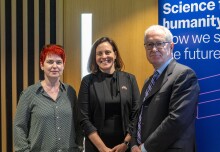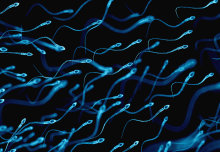

New data suggests dramatic activity on two of Saturn's moons<em> - News Release</em>
See also...
Press release issued by the Science and Technology Facilities Council
For immediate use
Thursday 14 June 2007
Saturn's moons Tethys and Dione are flinging great streams of particles into space, according to data from the NASA/ESA/ASI Cassini mission to Saturn, as reported in Nature (14th June). The discovery suggests the possibility of some sort of geological activity, perhaps even volcanic, on these icy worlds.
The particles were traced to the two moons because of the dramatic movement of electrically charged gas in the magnetic environs of Saturn. Known as plasma, the gas is composed of negatively charged electrons and positively charged ions, which are atoms with one or more electrons missing. Because they are charged, the electrons and ions can become trapped inside a magnetic field.
Saturn rotates in just 10 hours and 46 minutes. This sweeps the magnetic field and the trapped plasma through space. Just like a child on a fast-spinning merry-go-round, the trapped gas feels a force trying to throw it outwards, away from the centre of rotation.
Soon after the Cassini spacecraft reached Saturn, in June 2004, it revealed that the planet's hurried rotation squashes the plasma into a disc and that great fingers of gas are indeed being thrown out into space from the disc’s outer edges. Hotter, more tenuous plasma then rushes in to fill the gaps.
Now, Jim Burch (lead author on the Nature paper), Southwest Research Institute, San Antonio, Texas, and colleagues have made a careful study of these events using the Cassini Plasma Spectrometer (CAPS). They have shown that the direction of the ejected electrons points back towards Tethys and Dione. "It establishes Tethys and Dione as important sources of plasma in Saturn's magnetosphere," says Burch. Until this result, only Enceladus out of Saturn's inner moons was known to be an active world, with huge geysers spraying gases hundreds of kilometres above the moon's surface. "This new result seems to be a strong indication that there is activity on Tethys and Dione as well," says Dr Andrew Coates from the Mullard Space Science Laboratory, University College London, and a collaborator on this latest work.
Activity is a draw for planetary scientists as it means that the planet has yet to reach equilibrium, or is perhaps being supplied with energy. The activity on Enceladus was detected first by Cassini's Dual Technique Magnetometer (MAG). This led the flight team to schedule a particularly close pass of Enceladus, which revealed a wealth of data about Enceladus’ alien geysers – and spectacular pictures, too.
"The best results arise when we combine a variety of data sets to understand the observations," says Professor Michele Dougherty , Imperial College London, and Principal Investigator of MAG.
In the case of Dione and Tethys, more fly-bys are scheduled in the future, which will allow the team and the other instruments a close-up look at the moons. Before that happens, the team has to go back and search for further signs of activity in the data already collected during the Tethys and Dione flybys of 2005.
In addition, Burch says that having detected the electrons they will now be on the lookout for the ions, so that the composition of the Tethys and Dione plasmas can be determined.
For more information please contact:
Gill Ormrod – Science and Technology Facilities Council
Tel: 01793 442012
Mobile: 0781 8013509
Email: gill.ormrod@stfc.ac.uk
Notes to Editors:
More information on the Cassini mission is available at: www.esa.int/SPECIALS/Cassini-Huygens, http://www.nasa.gov/cassini and http://saturn.jpl.nasa.gov
The Cassini-Huygens mission is a cooperative project of NASA, the European Space Agency and the Italian Space Agency. The Jet Propulsion Laboratory, a division of the California Institute of Technology in Pasadena, manages the Cassini-Huygens mission for NASA's Science Mission Directorate, Washington. The Cassini orbiter was designed, developed and assembled at JPL. The Cassini Plasma Spectrometer team is based at the Southwest Research Institute in San Antonio. The magnetometer team is based at Imperial College London, working with team members from the United States and several European countries.
Science and Technology Facilities Council
• The Science and Technology Facilities Council ensures the UK retains its leading place on the world stage by delivering world-class science; accessing and hosting international facilities; developing innovative technologies; and increasing the socio-economic impact of its research through effective knowledge-exchange partnerships.
• The Council has a broad science portfolio including Astronomy, Particle Physics, Particle Astrophysics, Nuclear Physics, Space Science, Synchrotron Radiation, Neutron Sources and High Power Lasers. In addition the Council will manage and operate three internationally renowned laboratories:
• The Rutherford Appleton Laboratory, Oxfordshire
• The Daresbury Laboratory, Cheshire
• The UK Astronomy Technology Centre, Edinburgh
• The Council gives researchers access to world-class facilities and funds the UK membership of international bodies such as the European Laboratory for Particle Physics (CERN), the Institute Laue Langevin (ILL), European Synchrotron Radiation Facility (ESRF), the European organisation for Astronomical Research in the Southern Hemisphere (ESO) and the European Space Agency (ESA). It also contributes money for the UK telescopes overseas on La Palma, Hawaii, Australia and in Chile, and the MERLIN/VLBI National Facility, which includes the Lovell Telescope at Jodrell Bank Observatory.
The Science and Technology Facilities Council is a partner in the UK space programme, coordinated by the British National Space Centre.
-Ends-
Article text (excluding photos or graphics) available under an Attribution-NonCommercial-ShareAlike Creative Commons license.
Photos and graphics subject to third party copyright used with permission or © Imperial College London.





